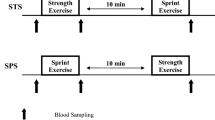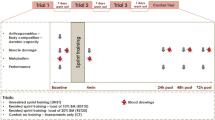Abstract
This study examined the effect of 6 weeks of prescribed sprint training on the human growth hormone (hGH) response to cycle ergometer sprinting. Sixteen male subjects were randomly assigned to a training (n=8) or a control (n=8) group. Each subject completed two main trials, consisting of two all-out 30-s cycle-ergometer sprints separated by 60 min of passive recovery, once before, and once after a 6-week training period. The training group completed three supervised sprint-training sessions per week in addition to their normal activity, whilst control subjects continued with their normal activity. In the training group, peak and mean power increased post-training by 6% (P<0.05) and 5% (P<0.05), respectively. Post-exercise blood pH did not change following training, but the highest post-exercise blood lactate concentrations were greater [highest measured value: 13.3 (1.0) vs 15.0 (1.1) mmol l−1], with lower blood lactate concentrations for the remainder of the recovery period (P<0.05). Post-exercise plasma ammonia concentrations were lower after training [mean highest measured value: 184.1 (9.8) vs 139.0 (11.7) μmol l−1, P<0.05]. Resting serum hGH concentrations did not change following training, but the peak values measured post-exercise decreased by over 40% in the training group [10.3 (3.1) vs 5.8 (2.5) μg l−1, P<0.05], and mean integrated serum hGH concentrations were 55% lower after training [567 (158) vs 256 (121) min μg l−1, P<0.05]. The hGH response to the second sprint was attenuated similarly before and after training. This study showed that 6 weeks of combined speed- and speed-endurance training blunted the human growth hormone response to sprint exercise, despite an improvement in sprint performance.

Similar content being viewed by others
References
Bloom SR, Johnson RH, Park DM, Rennie MJ, Sulaiman WR (1976) Differences in the metabolic and hormonal response to exercise between racing cyclists and untrained individuals. J Physiol (Lond) 258:1–18
Bonifazi M, Bela E, Lupo C, Martelli G, Zhu B, Carli G (1998) Influence of training on the response to exercise of adrenocorticotropin and growth hormone plasma concentrations in human swimmers. Eur J Appl Physiol 78:394–397
Brooks S, Cheetham ME, Williams C (1985) Endurance training and the catecholamine response to maximal exercise. J Physiol (Lond) 361:81P
Cappon J, Brasel JA, Mohan S, Cooper DM (1994) Effect of brief exercise on insulin-like growth factor I. J Appl Physiol 76:2490–2496
Dill DB, Costill DL (1974) Calculation of percentage changes in volumes of blood, plasma and red cells in dehydration. J Appl Physiol 37:247–248
Fry AC, Kraemer WJ, Ramsey LT (1998) Pituitary-adrenal-gonadal responses to high-intensity resistance exercise overtraining. J Appl Physiol 85:2352–2359
Harridge SDR, Bottinelli R, Canepari M, Pellegrino M, Reggiani C, Esbjornsson M, Balsom PD, Saltin B (1998) Sprint training, in vitro and in vivo muscle function, and myosin heavy chain expression. J Appl Physiol 84:442–449
Hortobagyi T, Houmard JA, Stevenson JR, Fraser DD, Johns RA, Israel RG (1993) The effects of detraining on power athletes. Med Sci Sports Exerc 25:929–935
Kjaer M, Secher NH, Bach FW, Galbo H (1987) Role of motor center activity for hormonal changes and substrate mobilization in humans. Am J Physiol 253:R687–R695
Kraemer WJ, Staron RS, Hagerman FC, Hikida RS, Fry AC, Gordon SE, Nindl BC, Gotsshalk LA, Volek JS, Marx JO, Newton RU, Hakkinen K (1998) The effects of short-term resistance training on endocrine function in men and women. Eur J Appl. Physiol 78:69–76
Lakomy HKA (1986) Measurement of work and power output using friction-loaded cycle ergometers. Ergonomics 29:509–517
Lanzi R, Tannenbaum GS (1992) Time-dependent reduction and potentiation of growth hormone (GH) responsiveness to GH-releasing factor induced by exogenous GH: a role for somatostatin. Endocrinology 130:1822–1828
Maughan RJ (1982) A simple, rapid method for the determination of glucose, lactate, pyruvate, alanine, 3-hydroxybutyrate and acetoacetate on a single 20-μl blood sample. Clin Chim Acta 122:231–240
McCall GE, Byrnes WC, Fleck SJ, Dickinson A, Kraemer WJ (1999) Acute and chronic hormonal responses to resistance training designed to promote muscle hypertrophy. Can J Appl Physiol 24:96–107
Mikines KJ, Kjaer M, Hagen C, Sonne B, Richter EA, Galbo H (1985) The effect of training on responses of β-endorphin and other pituitary hormones to insulin-induced hypoglycemia. Eur J Appl Physiol 54:476–479
Nevill ME, Boobis LH, Brooks S, Williams C (1989) Effect of training on muscle metabolism during treadmill sprinting. J Appl Physiol 67:2376–2382
Nevill ME, Holmyard DJ, Hall GM, Allsop P, van Oosterhout A, Burrin JM, Nevill AM (1996) Growth hormone responses to treadmill sprinting in sprint- and endurance-trained athletes. Eur J Appl Physiol 72:460–467
Pontiroli AE, Lanzi R, Monti LD, Sandoli E, Pozza G (1991) Growth hormone (GH) autofeedback on GH response to GH-releasing hormone. Role of free fatty acids and somatostatin. J Clin Endocrinol Metab 72:492–495
Roelen CAM, de Vries WR, Koppenschaar HPF, Vervoom C, Thijssen JHH, Blankenstein MA (1997) Plasma insulin-like growth factor –I and high affinity growth hormone-binding protein levels increase after two weeks of strenuous physical training. Int J Sports Med 18:238–241
Stathis CG, Febbraio MA, Carey MF, Snow RJ (1994) Influence of sprint training on human skeletal muscle purine nucleotide metabolism. J Appl Physiol 76:1802–1809
Stokes K (2003) Growth hormone responses to sub-maximal and sprint exercise. Growth Horm IGF Res 13:225–238
Stokes KA, Nevill ME, Hall GM, Lakomy HKA (2002a) Growth hormone responses to repeated maximal cycle ergometer exercise at different pedaling rates. J Appl Physiol 92:602–608
Stokes KA, Nevill ME, Hall GM, Lakomy HKA (2002b) The time-course of the human growth hormone response to a 6-s and a 30-s cycle ergometer sprint. J Sports Sci 20:487–494
Sutton JR, Young JD, Lazarus L, Hickie JB, Maksvytis J (1969) The hormonal response to physical exercise. Aust Ann Med 18:84–90
Urhausen A, Gabriel HHW, Kindermann W (1998) Impaired pituitary hormonal response to exhaustive exercise in overtrained endurance athletes. Med Sci Sports Exerc 30:407–414
Weltman A, Weltman JY, Schurrer R, Evans WS, Veldhuis JD, Rogol AD (1992) Endurance training amplifies the pulsatile release of growth hormone: effects of training intensity. J Appl Physiol 72:2188–2196
Weltman A, Weltman JY, Womack CJ, Davis SE, Blumer JL, Gaesser GA, Hartman ML (1997) Exercise training decreases the growth hormone (GH) response to acute constant-load exercise. Med Sci Sports Exerc 29:669–676
Weltman A, Pritzlaff CJ, Wideman L, Weltman JY, Blumer JL. Abbott RD Hartman ML, Veldhuis JD (2000) Exercise-dependent growth hormone release is linked to markers of heightened central adrenergic outflow. J Appl Physiol 89:629–635
Acknowledgement
The authors would like to express their gratitude to Mr. David Hompes for his assistance during this study.
Author information
Authors and Affiliations
Corresponding author
Rights and permissions
About this article
Cite this article
Stokes, K.A., Nevill, M.E., Cherry, P.W. et al. Effect of 6 weeks of sprint training on growth hormone responses to sprinting. Eur J Appl Physiol 92, 26–32 (2004). https://doi.org/10.1007/s00421-003-1038-5
Accepted:
Published:
Issue Date:
DOI: https://doi.org/10.1007/s00421-003-1038-5




